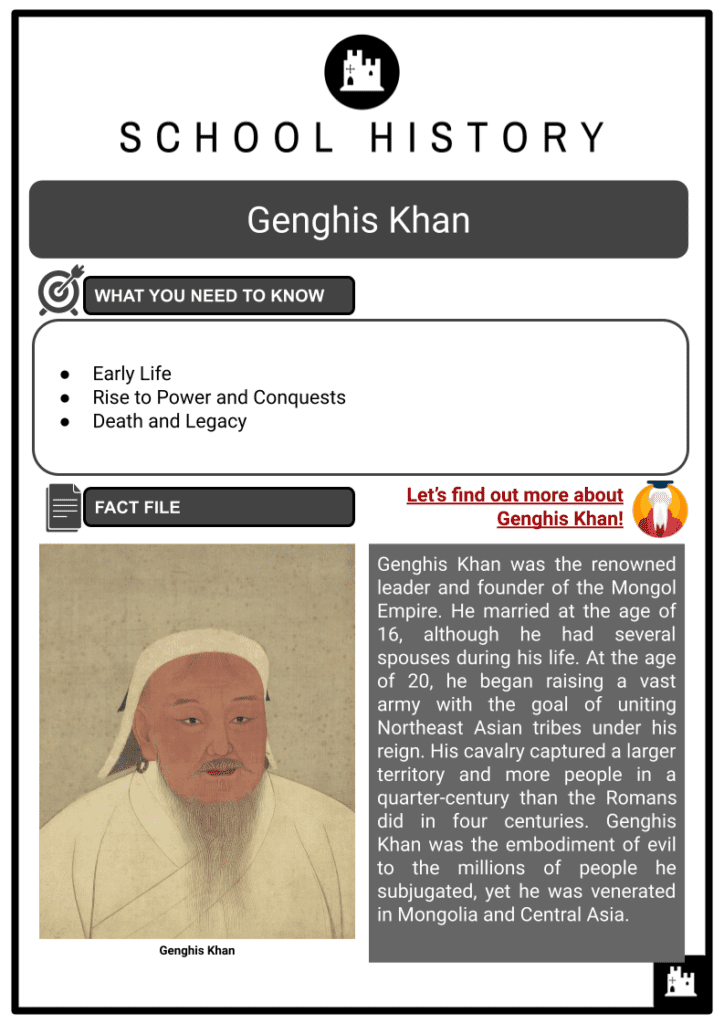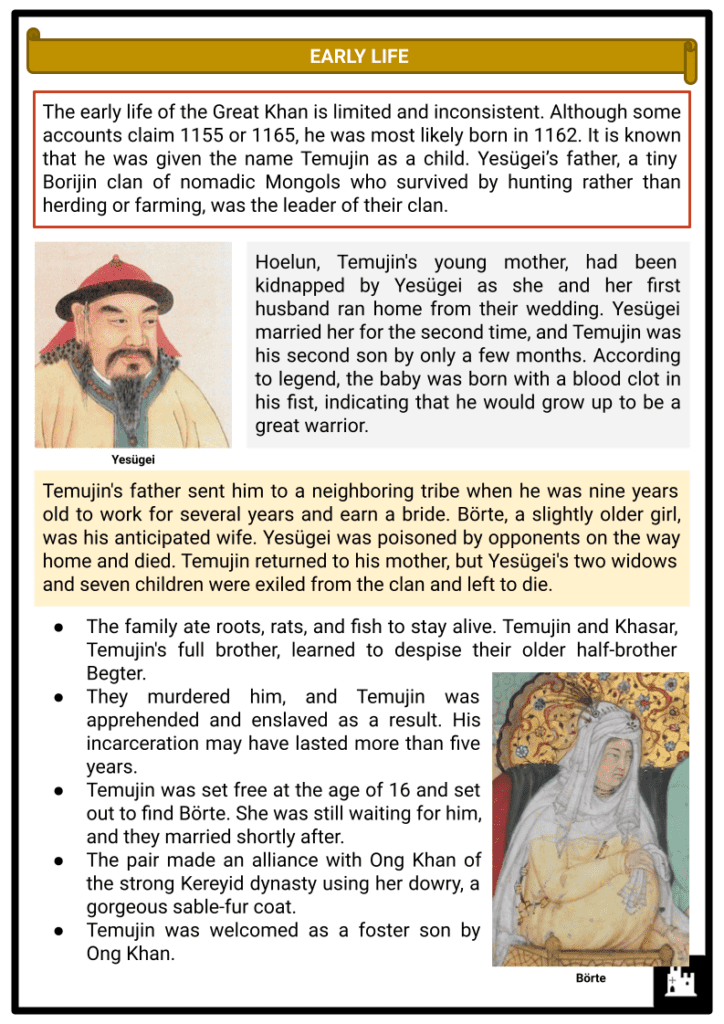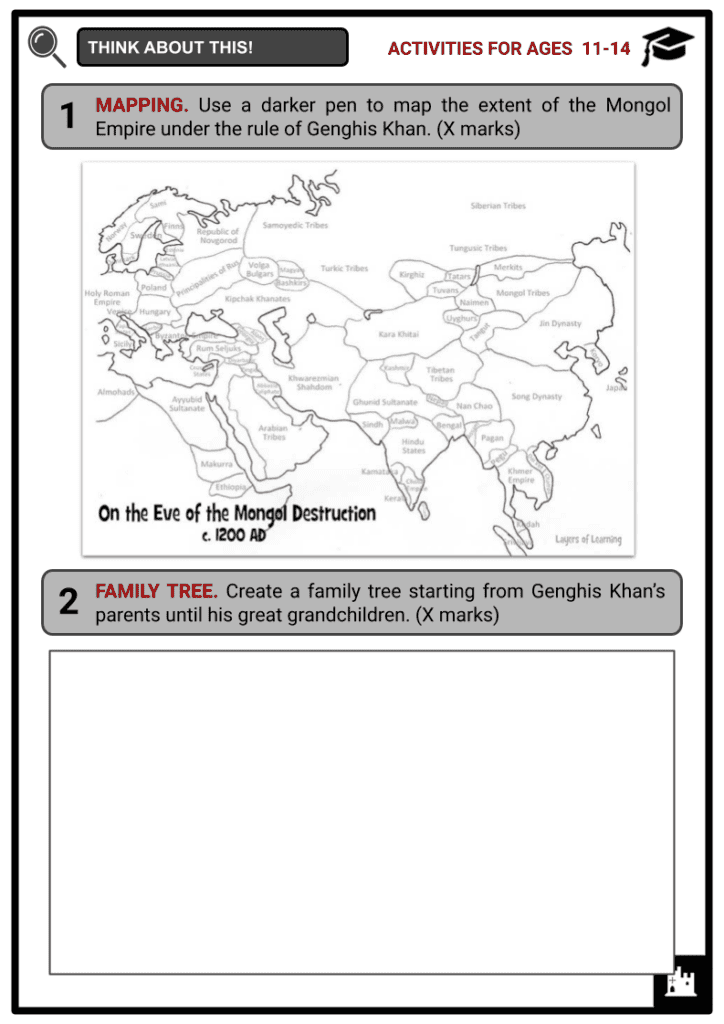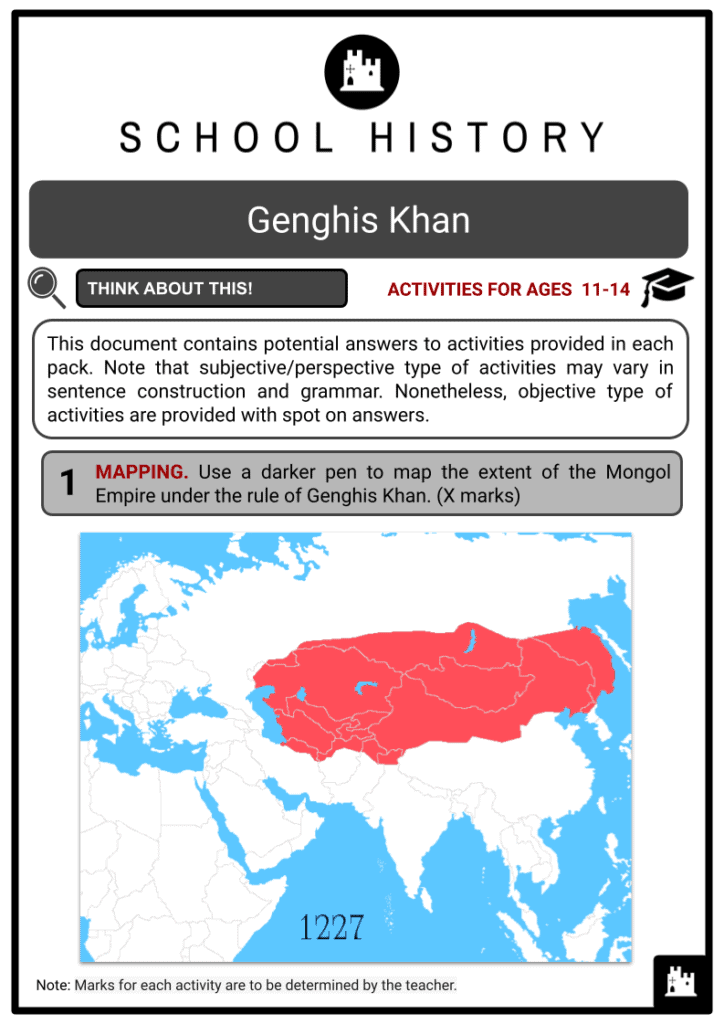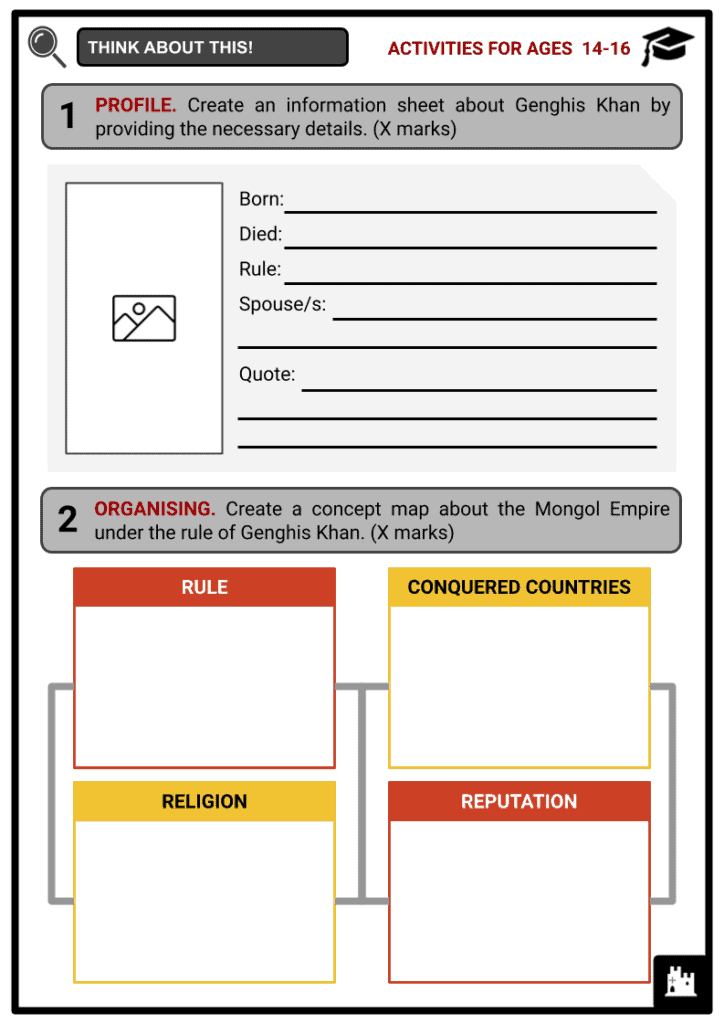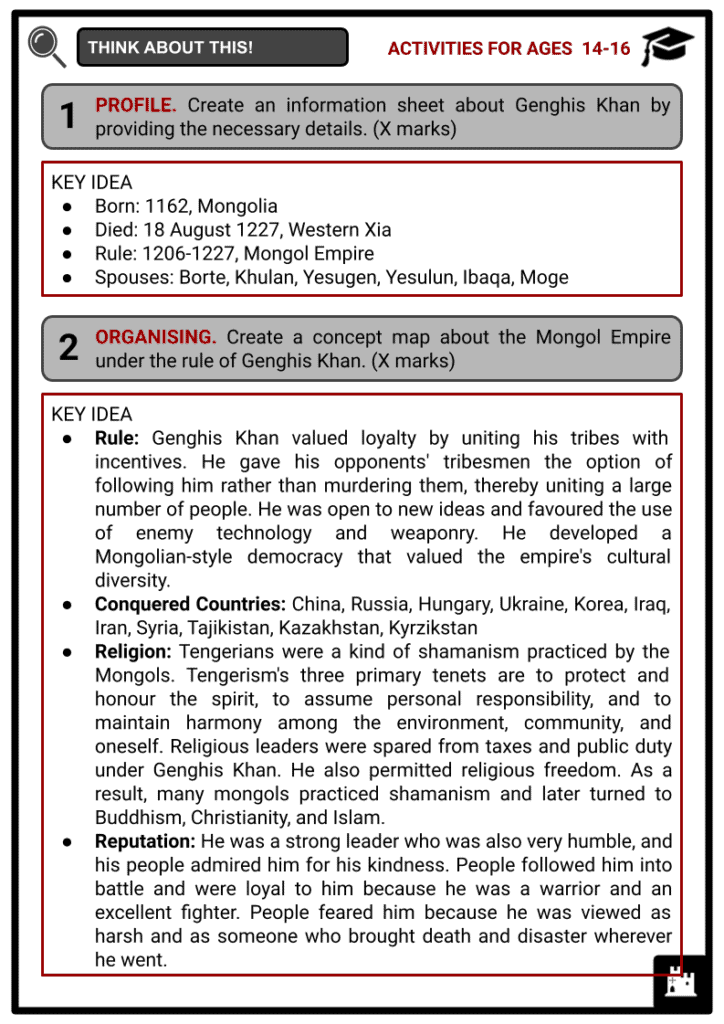Genghis Khan Worksheets
Do you want to save dozens of hours in time? Get your evenings and weekends back? Be able to teach about Genghis Khan to your students?
Our worksheet bundle includes a fact file and printable worksheets and student activities. Perfect for both the classroom and homeschooling!
Table of Contents
Add a header to begin generating the table of contents
Summary
- Early Life
- Rise to Power and Conquests
- Death and Legacy
Key Facts And Information
Let’s find out more about Genghis Khan!

- Genghis Khan was the renowned leader and founder of the Mongol Empire. He married at the age of 16, although he had several spouses during his life. At the age of 20, he began raising a vast army with the goal of uniting Northeast Asian tribes under his reign. His cavalry captured a larger territory and more people in a quarter-century than the Romans did in four centuries. Genghis Khan was the embodiment of evil to the millions of people he subjugated, yet he was venerated in Mongolia and Central Asia.
EARLY LIFE
- The early life of the Great Khan is limited and inconsistent. Although some accounts claim 1155 or 1165, he was most likely born in 1162. It is known that he was given the name Temujin as a child. Yesügei’s father, a tiny Borijin clan of nomadic Mongols who survived by hunting rather than herding or farming, was the leader of their clan.
- Hoelun, Temujin's young mother, had been kidnapped by Yesügei as she and her first husband ran home from their wedding. Yesügei married her for the second time, and Temujin was his second son by only a few months. According to legend, the baby was born with a blood clot in his fist, indicating that he would grow up to be a great warrior.
- Temujin's father sent him to a neighboring tribe when he was nine years old to work for several years and earn a bride. Börte, a slightly older girl, was his anticipated wife. Yesügei was poisoned by opponents on the way home and died. Temujin returned to his mother, but Yesügei's two widows and seven children were exiled from the clan and left to die.
- The family ate roots, rats, and fish to stay alive. Temujin and Khasar, Temujin's full brother, learned to despise their older half-brother Begter.
- They murdered him, and Temujin was apprehended and enslaved as a result. His incarceration may have lasted more than five years.
- Temujin was set free at the age of 16 and set out to find Börte. She was still waiting for him, and they married shortly after.
- The pair made an alliance with Ong Khan of the strong Kereyid dynasty using her dowry, a gorgeous sable-fur coat.
- Temujin was welcomed as a foster son by Ong Khan.
- Temujin's little band stayed with Jamukha's group for several years after rescuing Börte. Instead of treating Temujin as a brother, Jamukha quickly established his authority, igniting a two-decade rivalry between the 19-year-olds. Temujin, along with many of Jamukha's followers and livestock, departed the camp.
- Hoelun's Merkid clan planned to avenge her captivity by stealing Börte, and this partnership proved crucial. Temujin invaded the Merkids with the Kereyid army, plundering their camp and seizing Börte. Temujin's boyhood blood-brother Jamukha, who would later become a competitor, assisted him in the attack. Jochi, Börte's first son, arrived nine months later.
RISE TO POWER AND CONQUESTS
- Temujin conducted a kurultai (tribe council) among the Mongols at the age of 27, and they elected him Khan. However, the Mongols were simply a Kereyid sub-clan, and Ong Khan matched Jamukha and Temujin. Temujin, as Khan, bestowed high rank not just on his kin, but also on his most devoted supporters.
- Jamukha stormed Temujin's camp in 1190, ruthlessly horse-dragging and even burning his victims alive, angering many of his troops.
- Temujin Khan integrated the nearby Tatars and Jurchens rather than robbing and abandoning them, as was the steppe habit.
- In 1201, Jamukha invaded Ong Khan and Temujin. Temujin overcame and integrated Jamukha's surviving men despite getting an arrow to the neck.
- Ong Khan then tried to ambush Temujin during a wedding for Ong's daughter and Jochi, but the Mongols escaped and went on to conquer the Kereyids.
- Temujin was seized and temporarily enslaved by previous family allies, the Taichi'uts, when he was around 20 years old.
- He escaped with the assistance of a friendly prisoner and formed a combat squad with his siblings and many other clansmen.
- Temujin began his gradual rise to power by amassing a massive army of around 20,000 troops. He sought to break the old tribal barriers and unify the Mongols under his reign.
- Temujin avenged his father's death by completely destroying the Tatar army and ordering the execution of every Tatar man above 3 feet tall, using a mix of brilliant military skills and ruthless brutality (taller than the linchpin, or axle pin, of a wagon wheel). Temujin's Mongols then used a series of enormous cavalry attacks to destroy the Taichi'ut, including boiling all of their commanders alive. Temujin had also vanquished the formidable Naiman tribe by 1206, ceding sovereignty of central and eastern Mongolia to him.
- Temujin Khan's outstanding military strategy, as well as his knowledge of his foes' motives, contributed much to the Mongol army's early success. He had a large intelligence network and was quick to pick up new technology from his adversaries. The 80,000-strong Mongol army used a complex signaling system of smoke and burning torches to coordinate their advance.
- Commands to charge were given by large drums, and subsequent instructions were given by flag signals.
- A bow, arrows, shield, knife, and lasso were all carried by every soldier.
- He also had enormous saddlebags filled with food, tools, and extra clothing.
- When traversing deep and fast rivers, the saddlebag might be inflated to act as a life jacket.
- Cavalrymen were equipped with a short sword, javelins, body armor, a battle-axe or mace, and a lance with a hook to drag opponents off their horses.
- The attacks of the Mongols were terrible.
- Their hands were free to shoot arrows because they could control a galloping horse with only their legs.
- A well-organised supply system of oxcarts bringing food for soldiers and beasts alike, as well as military supplies, shamans for spiritual and medical treatment, and bureaucrats to record the plunder, trailed the entire army.
- Following Temujin's conquests against opposing Mongol tribes, other tribal leaders consented to peace and conferred upon him the title "Genghis Khan," which meant "universal ruler," and had both political and spiritual significance. Genghis Khan was proclaimed the representative of Mongke Koko Tengri (Eternal Blue Sky), the Mongols' greatest divinity.
- It was considered that his destiny was to govern the world after this declaration of heavenly status. The Mongol Empire maintained religious tolerance, yet rejecting the Great Khan was similar to disobeying God's decree.
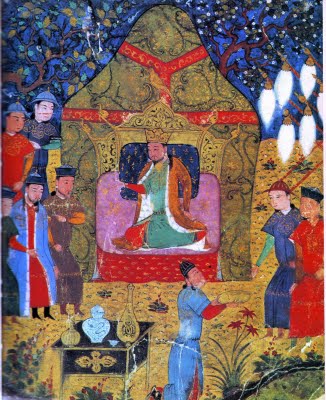
I am a flail of God. If you had not committed great sins, God would not have sent a punishment like me upon you.
- Genghis Khan made the most of his divine status right away. While spiritual inspiration drove his army, the Mongols were most likely influenced by environmental factors. As the population increased, food and resources became limited. He led his soldiers against the kingdom of Xi Xia in 1207 and forced it to submit after two years. Genghis Khan's army attacked the Jin Dynasty in northern China in 1211, drawn not by the aesthetic and scientific marvels of the big cities, but by the seemingly endless rice fields and easy pickings of wealth.
- Genghis Khan's forces were equally active in the west against border states and the Muslim world, despite the fact that the fight against the Jin Dynasty lasted over 20 years. Genghis Khan began by establishing commercial links with the Khwarizm Dynasty, a Turkish-dominated kingdom that spanned Turkestan, Persia, and Afghanistan. However, the governor of Otrar assaulted the Mongol diplomatic delegation, probably mistaking the caravan for a spy operation.
- When Genghis Khan learned of the insult, he ordered the governor's arrest and dispatched a diplomat to bring him back. The Khwarizm Dynasty's leader, Shah Muhammad, not only declined the demand, but also sent back the Mongol diplomat's head in contempt.
- This incident sparked a wrath that spread over Central Asia and Eastern Europe.
- In 1219, Genghis Khan assumed personal command of a three-pronged campaign with 200,000 Mongol warriors against the Khwarizm Dynasty.
- With unrelenting brutality, the Mongols swept past the defences of every city.
- Those who were not slain immediately were brought in front of the Mongol army and used as human shields when the Mongols conquered the next city.
- Small household animals and cattle were among those that killed. Men, women, and children's skulls were stacked into enormous pyramidal mounds.
- The Khwarizm Dynasty came to an end in 1221 when the Shah Muhammad and subsequently his son were arrested and executed, bringing the end to the Khwarizm Dynasty.
- The Pax Mongolica refers to the period after the Khwarizm campaign. Genghis Khan's conquests eventually linked China and Europe's key trading hubs. Yassa was the legal code that controlled the empire. The code, which was created by Genghis Khan and was based on Mongol common law, included edicts prohibiting blood feuds, adultery, stealing, and bearing false testimony. Laws expressing Mongol environmental sensitivity were also introduced, such as prohibitions on swimming in rivers and streams and instructions for every soldier following another to pick up anything that the prior soldier dropped. In most cases, breaking any of these laws resulted in death.
- Genghis Khan shifted his focus eastward to China after the Khwarizm Dynasty was destroyed. The Tanguts of Xi Xia had openly revolted against his instructions to supply men to the Khwarizm expedition. Genghis Khan fought opposing forces and demolished the capital of Ning Hia in a series of triumphs over Tangut towns. The struggle came to an end as one Tangut official after another surrendered. However, Genghis Khan didn't get nearly enough vengeance for the Tangut betrayal, and ordered the imperial family's death, thereby terminating the Tangut bloodline.
DEATH AND LEGACY
- Genghis Khan died in 1227, not long after the Xi Xia surrendered. His cause of death is uncertain. Some historians believe he died of exhaustion and injury after falling off a horse while hunting. Others claim he died of a respiratory illness. According to his tribe's customs, Genghis Khan was buried without marks near his birthplace, between the Onon River and the Khentii Mountains in northern Mongolia. According to legend, the funeral escort murdered everybody and everything they came across in order to hide the location of Genghis Khan's grave, and a river was diverted over his grave to make it hard to discover.
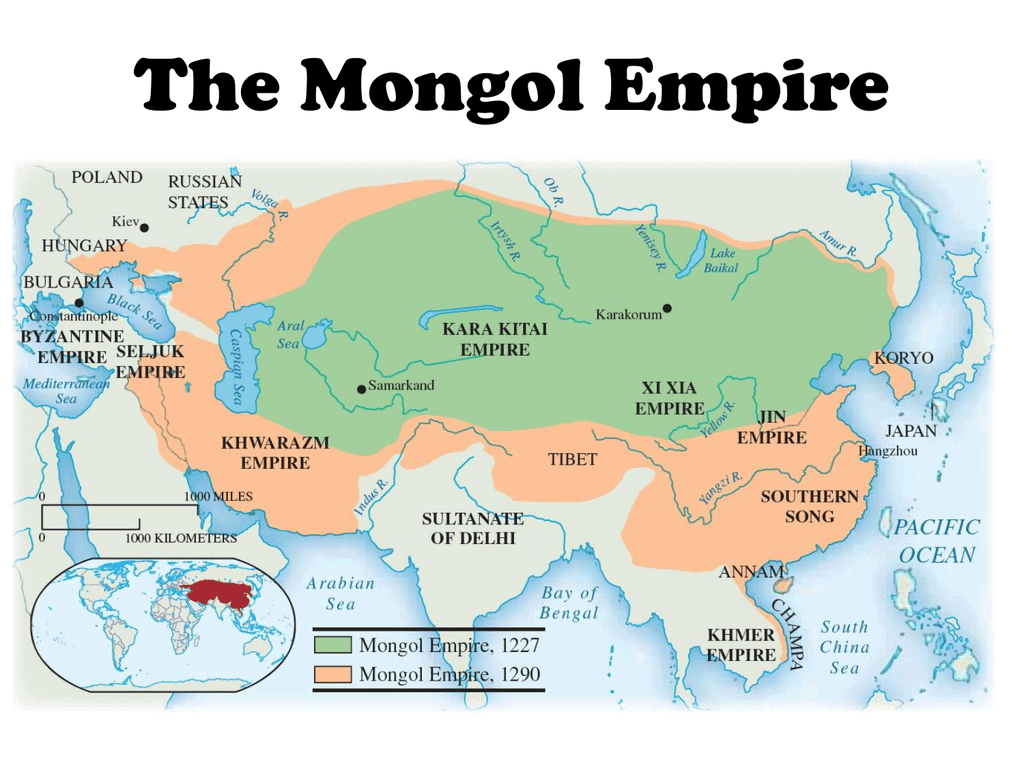
- The Great Khan outlawed the kidnapping of women, owing to his wife's experience, as well as the fact that it caused conflict amongst Mongol clans. For the same reason, he forbade livestock raiding and instituted a winter-only hunting season to conserve game for the worst of times.
- Despite his savage and cruel image in the west, Genghis Khan implemented a number of progressive initiatives that would not become general practice in Europe for generations. He protected the rights of Buddhists, Muslims, Christians, and Hindus alike, ensuring religious freedom. Although Genghis Khan revered the sky, he prohibited the slaughter of priests, monks, nuns, mullahs, and other religious figures.
- Within Mongolia, Genghis Khan modified conventional legislation and transformed the social system. His was an equal society, in which even the most enslaved individual may climb to the rank of army commander by talent and courage. All warriors, regardless of social standing, received an equal share of the battle gain. Unlike other monarchs of the period, Genghis Khan put his loyal subjects ahead of his own family, which made succession problematic as he became older.
- Genghis Khan placed absolute power to his son Ogedei, who ruled over most of eastern Asia, including China, before his death.
- The rest of the kingdom was split among his other sons: Chagatai seized control of central Asia and northern Iran; Tolui, the youngest, was given a tiny region near the Mongol heartland; and Jochi, the eldest, and his son, Batu, took control of modern-day Russia and founded the Golden Horde.
- Under Ogedei Khan's reign, the empire's growth proceeded and peaked. Mongol armies eventually conquered Persia, southern China's Song Dynasty, and the Balkans.
- Leading commander Batu received word of the Great Khan Ogedei's death just as the Mongol troops were approaching the gates of Vienna, Austria, and was summoned back to Mongolia.
- The expedition thus stalled, marking the Mongols' farthest advance into Europe.

